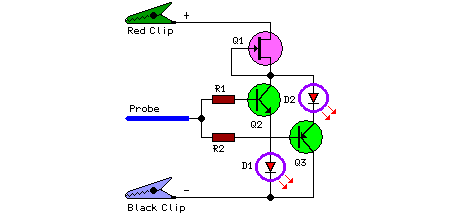Home » Circuits
Circuit Board Checker
Indicates the basic integrity of a printed board, Self-powered - 3 to 30V rangeThis little circuit indicates the basic integrity of a printed board, detecting 0V, positive supply voltage from less than 3V to 30V and floating parts. If the probe is floating, as it would be in a broken track, then both LEDs barely light up, since there is no current to drive the transistors, but if the probe touches 0V or a positive voltage one or other lights. A digital signal should light them in proportion to the mark-space ratio whereas the output of a circuit oscillating at a frequency rate below about 20Hz will cause the LEDs to flicker alternatively. The LEDs will illuminate always at a constant intensity, no matter the voltage supply used, because they are fed by a very simple FET constant-current generator (Q1).
Circuit diagram:
Parts:
R1 = 22K
R2 = 22K
D1 = Red LED
D2 = Green LED
Q1 = BF245
Q2 = BC547
Q3 = BC557
Notes:
- The Black clip must be connected to the negative ground of the board under test.
- The Red clip should be connected to a positive voltage source (not exceeding 30V) available on the same board.
- Metal probe is suitable for this circuit.
- Two Miniature Crocodile Clips (Red and Black) are also necessary.

